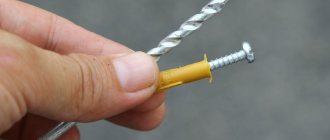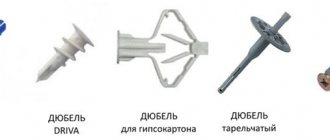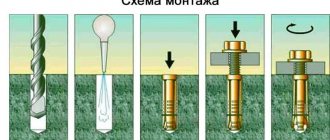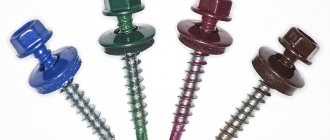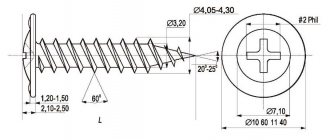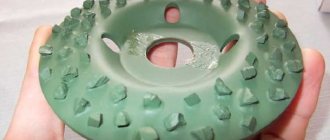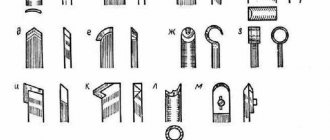Article reading time: 15 minutes
Author of the article:
One of the most common types of complex fasteners is the dowel-screw combination. It is used for fastening various parts, objects, structural elements to the surfaces of solid building materials - concrete, brick, wall blocks, natural stone. The fastening unit consists of two elements - a plastic or metal dowel, which is inserted into a hole pre-drilled in the base, and a screw, screwed into the dowel. When a screw is screwed in, the sides of the dowel expand and a frictional force arises between its outer surface and the surface of the hole walls. As a result, the fastener is securely held in the hole, withstanding significant operating loads.
Correct use of this fastening method allows you to obtain reliable connections with a long service life. One of the main conditions is the correct selection of fastening elements, which must be compatible with each other and suitable for specific conditions of use. For example, before performing work, you need to decide which screw to use for an 8 mm dowel, for a 6 mm dowel, or for another standard size used.
Material for making dowels
Most dowels are now made from polymer materials. This is due to their low cost and fairly good performance.
The main materials for the production of dowels are:
- Polyethylene. The material is easily deformed without collapsing. It is characterized by low weight and increased chemical resistance. Withstands negative temperatures down to −40 °C. The disadvantage of polyethylene is that over time it cracks and loses its performance.
- Polypropylene. It is characterized by significant hardness, resistance to wear and elevated temperatures. Due to the poor frost resistance of the material, the use of polypropylene fasteners is limited to indoor installation. During use, plugs may crack, especially when exposed to temperature changes.
- Polyamide (nylon). Plastic with increased resistance to wear and mechanical stress. The most common material for making dowels. Nylon fasteners are durable and last longer compared to fasteners made from other types of plastic.
In addition to plastic, dowels are also made of metal. They also produce fasteners made of galvanized carbon steel, stainless steel, and brass. Metal dowel fasteners have higher strength and rigidity, which allows them to withstand increased operating loads. However, metal is inferior to plastic in its ability to deform without breaking. In addition, metal dowels are significantly more expensive.
Dowel screw size
Dowel screws are available in different variations. The perfect size is key as it will ultimately decide the fate of the entire job. A smaller screw will not be able to hold the log or joints in place, while a larger one will not fit.
One size does not fit every activity. You can purchase a variety of screws if you are an active woodworker and test which one works best. As a rule, the screw should not be more than half the width of the log.
The shape of the dowel is another important criterion along with the size. A wider dowel will likely break the board, while a thinner one will not hold the joints in place completely. The most reliable way is to test it by trial and error. Then, over time, experience and an exact understanding of which dowel will fit perfectly will come.
Various shapes and sizes of dowel screws are available and marketed with this strategy to entice the consumer. You should always give preference to regular dowels and those that are easily available. Perfection is the only key that matters in carpentry.
How to choose the right dowel
To determine which dowel to choose for 8 screws, it is necessary to take into account not only the dimensional characteristics of the fastener, but also its design, which determines the scope of application of the fastener. Different types of dowel elements are produced according to their design.
The main types of dowels are:
- Polypropylene universal. When a screw is screwed in, the dowel material wraps around it. Well suited for working with various materials, including brick, concrete, natural stone.
- Universal spacer. Also made from polypropylene. It has spacers that move apart when the screw is screwed in, holding the part inside the hole.
- Nylon. Suitable for working with any materials. It is securely held in the hole with the help of special spacer antennae.
- Dowel nail. Polypropylene or nylon plug with steel driving nail. Allows you to quickly fasten profile elements, sheathing, sheet and slab materials.
- For drywall. Can be made of plastic or metal. Metal elements do not require pre-drilling for installation.
- Butterfly dowel. Also used for installation in drywall and various hollow materials.
- Dowel-umbrella (fungus). It has a round cap of significant diameter with perforation. It is used for covering walls with heat-insulating materials - polystyrene foam, mineral wool, etc.
- Adjustment. Used for installation of sheathing structures. The design of the fastening element provides the possibility of adjustment - adjusting the height of the fastening relative to the surface of the base.
- Dowel clamp. It is made of nylon, in the form of a loop with elongated legs that are inserted into the mounting hole. Used for open cable laying along the surface of a wall or floor slab.
When completing the assembly assembly, it is necessary to select the diameter and length of both the dowel and the self-tapping screw, as well as the depth of the hole to be drilled. First of all, the dowel is selected according to diameter and length. The larger the part size, the greater the load the fastener can withstand. For light loads, you can use clamps of small diameters - 4 mm and 5 mm. Dowels with a diameter of 6 mm, 8 mm are suitable for medium loads, with a diameter of 1 mm and 12 mm can be used for significant operating loads. For heavily loaded mounting units, dowel elements with a diameter of 14 mm and 16 mm are used.
In addition, you need to choose which drill to drill the mounting hole with. The drill is selected in accordance with the standard size of the dowel - their numbers must match. It is important that the plug fits tightly enough into the hole in order to ensure reliable fastening and prevent the dowel from twisting and falling out. When making large-diameter holes in concrete, brick and other materials, it is recommended to initially work with a drill of a smaller diameter in impact mode. After this, the hole is drilled to the required diameter using a standard-size drill without impact mode.
How to use dowel screws
There are many ways in which carpentry dowels can be used. The recommendations below do not claim to be the ultimate truth, so as to be considered the only correct option for using dowel screws. This is just one clear example demonstrating how dowel screws are used:
- Drill starting (pilot) holes in the wood, and let the dowel screws do the rest. Find a drill bit narrower than the dowel. If you don't make the hole narrower, the dowel screw will have nothing to grab onto as it penetrates the material.
- For a dining table or bar stool, you need to clamp the leg in a straight up and down position in relation to the portable desk. To do this, place your foot in the clamp and tighten it. It is required to take a level up against the leg to determine whether the piece of wood is plumb. Next, set a level on the top of the leg to see if it is level. Drill a hole in the leg and shake off excess sawdust.
- Tighten the dowel screws. To do this, you need to inject a little wood glue into the pilot hole that was previously made. You then need to insert the head into the cordless screwdriver and continue turning the dowel screw until the last edge of the thread disappears into the wood. Allow the glue to dry completely.
Finally, you need to drill a hole in the piece of furniture that comes with the leg. Rotate the leg clockwise or to the right to tighten the dowel screw into the larger piece of furniture. Once all the legs are in place, the table or chair should be placed upright in its normal position.
Classification of screws
The correct selection of screws is key to forming a reliable and stable connection. For installation, as a rule, screws or self-tapping screws with a countersunk, semi-countersunk head are used. Less commonly used are hardware with a semicircular or hexagonal head. The type of head is selected based on the type and design features of the parts fixed to the surface of the base. The key parameter when choosing is the diameter of the screw, which is selected depending on the diameter of the dowel element. If you choose smaller hardware, it will not be able to sufficiently open the dowel when screwing it in, which will not allow you to create a reliable connection. A self-tapping screw that is too thick simply cannot be screwed in.
The selection of diameters is carried out as follows:
- For a 4 mm dowel element - a 2 mm screw.
- For a 5 mm dowel - a self-tapping screw from 2 mm to 3 mm.
- For a 6 mm dowel - a self-tapping screw from 3.5 mm to 4.5 mm.
- An 8 mm dowel accepts a screw from 4.5 mm to 5.5 mm.
- Dowel 10 requires a screw from 5.5 mm to 6.5 mm.
- For a 12 mm dowel - a screw from 6.5 mm to 8.5 mm.
- For 14 mm dowels, select a self-tapping screw with a diameter from 0.5 mm to 10.5 mm.
- For dowel elements with a diameter of 16 mm, self-tapping screws with a diameter of 10.5 mm to 12.5 mm are used.
It is important to choose the length of the self-tapping screw to be installed. When screwing in hardware that is not long enough, the dowel will not open completely. As a result, it will not be securely fixed in the mounting hole and will rotate. In this case, the connection will not be reliable and will not withstand operating loads. To select the correct size, you need to take the length of the dowel being installed and add to it the thickness of the attached part. The result is the minimum required screw length. It may be larger, but in this case it is important to drill the hole to the appropriate depth. It is necessary to take into account the restrictions on the thickness of the attached parts depending on. When installing on a solid base, this size should not be more than 60% of the dowel length. When working on loose bases, the limit is 35%.
What must be taken into account when choosing a self-tapping screw?
When searching for a suitable self-tapping screw with dowel, be sure to take into account the length of the screw tip depending on the thickness of the material that needs to be secured. In addition, before you start screwing in the screw, you should make sure that there is enough space where the tip of the drilled screw will enter the material.
This will reduce thread stripping that may occur when screwing in a self-tapping screw. We must not forget that the thread strip can affect the bond density and overall strength of the material. Rotating the screws can lead to the formation of metal shavings between the mating parts. This leads to restrictions on their use in food, electrical and other fields.
Dimensions of metal screws
Typically they include:
- nominal dimensions of metal screws;
- outer and inner diameter;
- physical length;
- number of thread turns.
A metal self-tapping screw is a kind of pointed rod with a head. The thread is self-tapping and the screw type is rigid. The main materials are stainless steel, carbon steel, alloys with copper, aluminum and titanium.
Metal screws can be divided into self-tapping screws with a pan head, with a flat head or a round head. There are also self-tapping screws with an umbrella head, hexagonal screws, etc., depending on the shape of the head.
Different screw diameters and head shapes drill different sized holes in the material to be fastened. If it is a special type of groove, then its size must also be determined. The most common types of metal screws in practice are Phillips head screws.
Dowel selection table
A special table will help you choose the right screw for a dowel of a certain size and determine the required parameters of the mounting hole.
| Screw dimensions | Dowel dimensions | Hole dimensions | |||
| Diameter, mm | Length, mm | Diameter, mm | Length, mm | Drill diameter, mm | Drilling depth, mm |
| 3 | 12, 16, 20, 25, 30, 35, 40 | 5 | 12, 16, 20, 25, 30, 35, 40 | 5 | 16, 20, 25, 30, 35, 40, 45 |
| 3,5 | 12, 16, 20, 25, 30, 35, 40, 45, 50 | 6 | 12, 16, 20, 25, 30, 35, 40, 45, 50 | 6 | 16, 20, 25, 30, 35, 40, 45, 50, 55 |
| 4 | 12, 16, 20, 25, 30, 35, 40, 45, 50, 60, 70 | 5 or 6 | 12, 16, 20, 25, 30, 35, 40, 45, 50, 60, 70 | 5 or 6 | 16, 20, 25, 30, 35, 40, 45, 50, 55, 65, 75 |
| 4,5 | 16, 20, 25, 30, 35, 40, 45, 50, 60, 70, 80 | 6 or 8 | 16, 20, 25, 30, 35, 40, 45, 50, 60, 70, 80 | 6 or 8 | 20, 25, 30, 35, 40, 45, 50, 55, 65, 75, 85 |
| 5 | 20, 25, 30, 35, 40, 45, 50, 60, 70, 80, 90, 100 | 6 or 8 | 16, 20, 25, 30, 35, 40, 45, 50, 60, 70, 80, 90, 100 | 6 or 8 | 20, 25, 30, 35, 40, 45, 50, 55, 65, 75, 85, 95, 105 |
| 6 | 40, 45, 50, 60, 70, 80, 90, 100, 120, 140, 160, 180, 200 | 8 or 10 | 40, 45, 50, 60, 70, 80, 90, 100, 120, 140, 160, 180, 200 | 8 or 10 | 45, 50, 55, 65, 75, 85, 95, 105, 130, 150, 170, 190, 220 |
| 8 | 40, 45, 50, 60, 70, 80, 90, 100, 120, 140, 160, 180, 200 | 10 or 12 or 14 | 40, 45, 50, 60, 70, 80, 90, 100, 120, 140, 160, 180, 200 | 10 or 12 or 14 | 45, 50, 55, 65, 75, 85, 95, 105, 130, 150, 170, 190, 220 |
| 10 | 40, 45, 50, 60, 70, 80, 90, 100, 120, 140, 160, 180, 200, 220, 240, 260 | 12 or 14 | 40, 45, 50, 60, 70, 80, 90, 100, 120, 140, 160, 180, 200, 220, 240, 260 | 12 or 14 | 45, 50, 55, 65, 75, 85, 95, 105, 130, 150, 170, 190, 220, 230, 260, 280 |
